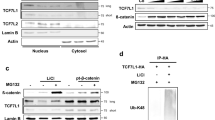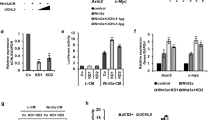Abstract
Interactions between β-catenin and LEF-1/TCF, APC and conductin/axin are essential for wnt-controlled stabilization of β-catenin and transcriptional activation. The wnt signal transduction pathway is important in both embryonic development and tumor progression. We identify here amino acid residues in β-catenin that distinctly affect its binding to LEF-1/TCF, APC and conductin. These residues form separate surface clusters, termed hot spots, along the armadillo superhelix of β-catenin. We also show that complementary charged and hydrophobic amino acids are required for formation of the bipartite β-catenin–LEF-1 transcription factor. Moreover, we demonstrate that conductin/axin binding to β-catenin is essential for β-catenin degradation, and that APC acts as a cofactor of conductin/axin in this process. Binding of APC to conductin/axin activates the latter and occurs between their SAMP and RGS domains, respectively.
This is a preview of subscription content, access via your institution
Access options
Subscribe to this journal
Receive 12 print issues and online access
$189.00 per year
only $15.75 per issue
Buy this article
- Purchase on Springer Link
- Instant access to full article PDF
Prices may be subject to local taxes which are calculated during checkout






Similar content being viewed by others
References
Peifer, M. & Wieschaus, E. The segment polarity gene armadillo encodes a functionally modular protein that is the Drosophila homolog of human plakoglobin. Cell 63, 1167–1176 (1990).
McCrea, P.D., Turck, C.W. & Gumbiner, B. A homolog of the armadillo protein in Drosophila (plakoglobin) associated with E-cadherin. Science 254,1359–1361 (1991).
Cadigan, K.M. & Nusse R. Wnt signaling: a common theme in animal development. Genes Dev. 11, 3286–3305 (1997).
Näthke, I.S., Hinck, L., Swedlow, J.R., Papkoff, J. & Nelson, W.J. Defining interactions and distributions of cadherin and catenin complexes in polarized epithelial cells. J. Cell Biol. 125, 1341–1352 (1994).
Hülsken, J., Birchmeier, W. & Behrens, J. E-cadherin and APC compete for the interaction with β-catenin and the cytoskeleton. J. Cell Biol. 127, 2061–2069 (1994).
Aberle, H., et al. Assembly of the cadherin-catenin complex in vitro with recombinant proteins. J. Cell Sci. 107, 3655–3663 (1994).
Funayama, N., Fagotto, F., McCrea, P. & Gumbiner, B.M. Embryonic axis induction by the armadillo repeat domain of β-catenin: evidence for intracellular signaling. J. Cell Biol. 128, 959–968 (1995).
Willert, K. & Nusse R. β-Catenin: a key mediator of Wnt signaling. Curr. Opin. Genet. Dev. 8, 95–102 (1998).
Peifer, M., Pai, L.M. & Casey M. Phosphorylation of the Drosophila adherens junction protein Armadillo: roles for wingless signal and zeste-white 3 kinase. Dev. Biol. 166, 543–556 (1994).
Rubinfeld, B., et al. Binding of GSK-3β to the APC-beta-catenin complex and regulation of complex assembly. Science 272, 1023–1026 (1996).
Munemitsu, S., Albert, I., Souza, B., Rubinfeld, B. & Polakis, P. Regulation of intracellular β-catenin levels by the adenomatous polyposis coli (APC) tumor-suppressor protein. Proc. Natl. Acad. Sci. USA 92, 3046–3050 (1995).
Aberle, H., Bauer, A., Stappert, J., Kispert, A. & Kemler, R. β-catenin is a target for the ubiquitin-proteasome pathway. EMBO J. 16, 3797–3804 (1997).
Behrens, J., et al. Functional interaction of β-catenin with the transcription factor LEF-1. Nature 382, 638–642 (1996).
Molenaar, M., et al. XTcf 3 transcription factor mediates β-catenin-induced axis formation in Xenopus embryos. Cell 86, 391–399 (1996).
He, X., et al. A member of the frizzled protein family mediating axis induction by Wnt-5A. Science 275, 1652–1654 (1997).
Tetsu, O. & McCormick, F. β-Catenin regulates expression of cyclin D1 in colon carcinoma cells. Nature 398, 422–426 (1999).
Zeng, L., et al. The mouse Fused locus encodes Axin, an inhibitor of the Wnt signaling pathway that regulates embryonic axis formation. Cell 90, 181–192 (1997).
Behrens, J., et al. Functional interaction of an axin homolog, conductin, with β-catenin, APC, and GSK-3β. Science 280, 596–599 (1998).
Jiang, J. & Struhl, G. Regulation of the Hedgehog and Wingless signalling pathways by the F-box/WD40-repeat protein Slimb. Nature 391, 493–496 (1998).
Winston, JT., et al. The SCF β-TRCP-ubiquitin ligase complex associates specifically with phosphorylated destruction motifs in I kappa B α- and β-catenin and stimulates I kappa B α ubiquitination in vitro. Genes Dev. 13, 270–283 (1999).
Rubinfeld, B., et al. Stabilization of β-catenin by genetic defects in melanoma cell lines. Science 275, 1790–1792 (1997).
Morin, P.J., et al. Activation of β-catenin-Tcf signaling in colon cancer by mutations in β-catenin or APC. Science 275, 1787–1790 (1997).
Korinek, V., et al. Constitutive transcriptional activation by a β-catenin-Tcf complex in APC−/− colon carcinoma. Science 275, 1784–1787 (1997).
Polakis, P. The adenomatous polyposis coli (APC) tumor suppressor. Biochim. Biophys. Acta 1332, F127–147 (1997).
Rubinfeld, B., et al. Association of the APC gene product with β-catenin. Science 262, 1731–1734 (1993).
Su, L.-K., Vogelstein, B. & Kinzler, K.W. Association of the APC tumor suppressor protein with catenins. Science 262, 1734–1737 (1993).
Stappert, J. & Kemler, R. A short core region of E-cadherin is essential for catenin binding and is highly phosphorylated. Cell Adhes. Commun. 2, 319–327 (1994).
Huber, O., et al. Nuclear localization of β-catenin by interaction with transcription factor LEF-1. Mech. Dev. 59, 3–10 (1996).
Ikeda, S., et al. Axin, a negative regulator of the Wnt signaling pathway, forms a complex with GSK-3 β and β-catenin and promotes GSK-3 β-dependent phosphorylation of β-catenin. EMBO J. 17, 1371–1384 (1998).
Orsulic, S. & Peifer, M. An in vivo structure-function study of armadillo, the β-catenin homologue, reveals both separate and overlapping regions of the protein required for cell adhesion and for wingless signaling. J. Cell Biol. 134, 1283–1300 (1996).
van de Wetering, M., et al. Armadillo coactivates transcription driven by the product of the Drosophila segment polarity gene dTCF. Cell 88, 789–799 (1997).
Sadot, E., Simcha, I., Shtutman, M., Ben-Ze'ev, A. & Geiger, B. Inhibition of β-catenin-mediated transactivation by cadherin derivatives. Proc. Natl. Acad. Sci. USA 22, 15339–15344 (1998).
Orsulic, S., Huber, O., Aberle, H., Arnold, S. & Kemler, R. E-cadherin binding prevents β-catenin nuclear localization and β-catenin/LEF-1-mediated transactivation. J. Cell Sci. 112, 1237–1245 (1999).
Huber, A.H., Nelson, W.J. & Weis, W.I. Three-dimensional structure of the armadillo repeat region of β-catenin. Cell 90, 871–882 (1997).
Brunner, E., Peter, O., Schweizer, L. & Basler, K. Pangolin encodes a LEF-1 homologue that acts downstream of Armadillo to transduce the Wingless signal in Drosophila. Nature 385, 829–833 (1997).
Hsu, S.C., Galceran, J. & Grosschedl, R. Modulation of transcriptional regulation by LEF-1 in response to Wnt-1 signaling and association with β-catenin. Mol. Cell. Biol. 18, 4807–4818 (1998).
Omer, C.A., Miller, P.J., Diehl, R.E. & Kral, A.M. Identification of Tcf4 residues involved in high-affinity β-catenin binding. Biochem. Biophys. Res. Commun. 256, 584–590 (1999).
Rubinfeld, B., Albert, I., Porfiri, E., Munemitsu, S. & Polakis, P. Loss of β-catenin regulation by the APC tumor suppressor protein correlates with loss of structure due to common somatic mutations of the gene. Cancer Res. 57, 4624–4630 (1997).
Clackson, T., Ultsch, M.H., Wells, J.A & de Vos, A.M. Structural and functional analysis of the 1:1 growth hormone:receptor complex reveals the molecular basis for receptor affinity. J. Mol. Biol. 17, 1111–1128 (1998).
de La Coste, A., et al. Somatic mutations of the β-catenin gene are frequent in mouse and human hepatocellular carcinomas. Proc. Natl. Acad. Sci. USA 95, 8847–8851 (1998).
Chan, E.F., Gat, U., McNiff, J.M. & Fuchs, E. A common human skin tumor is caused by activating mutations in β-catenin. Nature Genet. 21, 410–413 (1999).
Ilyas, M., Tomlinson, I.P., Rowan, A., Pignatelli, M. & Bodmer, W.F. β-catenin mutations in cell lines established from human colorectal cancers. Proc. Natl. Acad. Sci. USA 94, 10330–10334 (1997).
Kitagawa, M., et al. An F-box protein, FWD1, mediates ubiquitin-dependent proteolysis of β–catenin. EMBO J. 18, 2401–2410 (1999).
Hart, M.J, de los Santos, R., Albert, I.N., Rubinfeld, B. & Polakis, P. Downregulation of β-catenin by human Axin and its association with the APC tumor suppressor, β-catenin and GSK-3β. Curr. Biol. 8, 573–581 (1998).
Salic, A., Lee, E., Mayer, L. & Kirschner, M.W. Control of β-catenin stability: reconstitution of the cytoplasmic steps of the wnt pathway in Xenopus egg extracts. Mol. Cell 5, 523–532 (2000).
Polakis P. The oncogenic activation of β-catenin. Curr. Opin. Genet. Dev. 9, 15–21 (1999).
Smits, R., et al. Apc1638T: a mouse model delineating critical domains of the adenomatous polyposis coli protein involved in tumorigenesis and development. Genes Dev. 13, 1309–1321 (1999).
Nicholls, A., Sharp, K. & Honig, B. Proteins 11, 281–283 (1991).
Kraulis, P.J. J. Appl. Crystallogr. 24, 946–950 (1991).
Giese, K. & Grosschedl, R. LEF-1 contains an activation domain that stimulates transcription only in a specific context of factor-binding sites. EMBO J. 12, 4667–4676 (1993).
Acknowledgements
We would like to thank C. Birchmeier (Berlin), A.H. Huber and W.I. Weis (Stanford) for critical reading of the manuscript and for helpful discussions, H. Clevers (Utrecht) for the IIA1.6 cells and reporter constructs, W. Altenhofen (Ludwigshafen), J. Joachim Müller and T. Schwartz (Berlin) for help with the analysis of structural data of β-catenin, and the Deutsche Forschungsgemeinschaft for financial support.
Author information
Authors and Affiliations
Corresponding author
Rights and permissions
About this article
Cite this article
von Kries, J., Winbeck, G., Asbrand, C. et al. Hot spots in β-catenin for interactions with LEF-1, conductin and APC. Nat Struct Mol Biol 7, 800–807 (2000). https://doi.org/10.1038/79039
Received:
Accepted:
Issue Date:
DOI: https://doi.org/10.1038/79039
This article is cited by
-
Inhibition of cell proliferation and promotion of acinus-like structure formation from goat mammary epithelial cells via Wnt/β-catenin signaling
In Vitro Cellular & Developmental Biology - Animal (2021)
-
Angiogenesis in a 3D model containing adipose tissue stem cells and endothelial cells is mediated by canonical Wnt signaling
Bone Research (2017)
-
Pathology and pathogenesis of craniopharyngiomas
Pituitary (2013)
-
Small molecule-based disruption of the Axin/β-catenin protein complex regulates mesenchymal stem cell differentiation
Cell Research (2012)
-
Mouse Tcf3 represses canonical Wnt signaling by either competing for β-catenin binding or through occupation of DNA-binding sites
Molecular and Cellular Biochemistry (2012)



